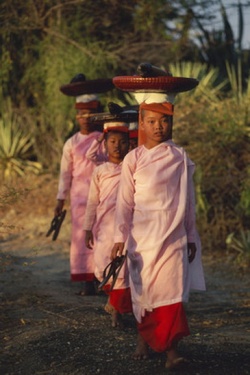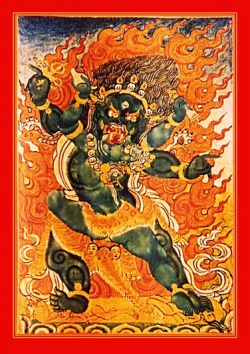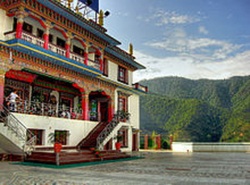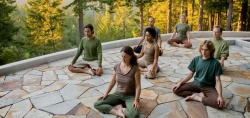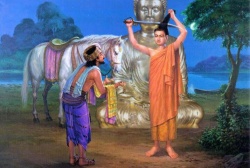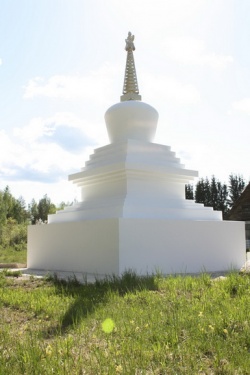Thirty-two major marks of a buddha
Jump to navigation
Jump to search
The thirty–two major marks of a buddha (Tib. མཚན་བཟང་པོ་སུམ་ཅུ་རྩ་གཉིས་) are:
- On the palms of his hands and the soles of his feet are the designs of a thousand-spoked wheel that protrudes, as if stamped from a mould.(Tib. ཕྱག་ཞབས་ཀྱི་མཐིལ་ན་འཁོར་ལོ་རྩིབས་སྟོང་གི་རྣམ་པ་རྒྱ་ལས་རྒྱ་ཡི་འབུར་དོད་པ་ལྟ་བུས་མཚན་པ་དང༌། )
- The soles of his feet are even and wellset, like the belly of a tortoise. (Tib. ཞབས་ཀྱི་མཐིལ་གཉིས་རུས་སྦལ་གྱི་ལྟོ་བ་ལྟར་མཉམ་ཞིང་ལེགས་པར་གནས་པ་དང༌། )
- The fingers on his hands and the toes on his feet are, like the swan, connected with a web [made of light]. (Tib. ཕྱག་ཞབས་ཀྱི་སོར་མོ་ངང་པ་ལྟར་ ་བས་འབྲེལ་བ་དང༌། )
- His arms and legs are smooth and firm. (Tib. ཕྱག་དང་ཞབས་འཇམ་ཞིང་གཞོན་ཤ་ཆགས་པ་དང༌། )
- The seven parts of his body are rounded — the wrists of his hands and ankles of his feet, the two shoulders and his neck, making seven, are rounded by being full, curved and without indentations. (Tib. སྐུ་ཡི་གནས་བདུན་མཐོ་བ་སྟེ། ཕྱག་ཞབས་ཀྱི་རྒྱབ་བཞི་ཕྲག་པ་གཉིས་ལྟག་པ་དང་བདུན་པོ་ཤོང་བུ་མེད་པར་རྒྱས་ཤིང་གང་སྟེ་མཐོ་བ་དང༌། )
- His fingers and toes are long. (Tib. ཕྱག་ཞབས་ཀྱི་སོར་མོ་རིང་བ་དང༌། )
- These four — the ball and heel of each foot — are prominent and broad. (Tib. རྒྱབ་ཀྱི་རྟིང་པ་བཞི་ཆ་ཕྱིར་འཕགས་ཤིང་ཡངས་པ་དང༌། )
- Taller than the ordinary man, his body is about seven cubits, large and straight, firm like a diamond and endowed with the strength of Vishnu. (Tib. ཕལ་པ་ལས་ཁྲུ་བདུན་ཙམ་དུ་སྐུ་ཆེ་ཞིང་དྲང་བ་རྡོ་རྗེ་ལྟར་མཁྲེགས་ལ་སྲེད་མེད་བུའི་སྟོབས་མངའ་བ་དང༌། )
- No protrusions are visible on his ankles and knees. (Tib. ཞབས་ཀྱི་ལོང་བུ་ལྷ་ང་བཅས་པའི་འབུར་མི་མངོན་པ་དང༌། )
- The hairs on his body grow in an upward direction. (Tib. སྐུའི་བ་སྤུ་ཐམས་ཅད་གྱེན་དུ་ཕྱོགས་པར་སྐྱེས་པ་དང༌། )
- His calves are round, full and beautiful like those of the enaya deer. (Tib. བྱིན་པ་རི་དྭགས་ཨེ་ན་ཡ་དང་འདྲ་བར་ཟླུམ་ལ་རྒྱས་ཤིང་མཛེས་པ་དང༌། )
- His arms are long and beautiful, and when extended they can cover his kneecaps, even without bending his body. (Tib. སྐུ་མ་བཏུད་ཀྱང་ཕྱག་བསྐྱང་བ་པུས་མོའི་ལྷ་ངར་སླེབ་པས་ཕྱག་རིང་ཞིང་མཛེས་པ་དང༌། )
- Like an elephant or a stallion, his genitals i.e., private parts are drawn up within a sheath. (Tib. གླང་པོའམ་རྟ་ཅང་ཤེས་ལྟར་འདོམས་ཀྱི་སྦ་བ་སྟེ་གསང་བ་སྦུབས་སུ་ནུབ་པ་དང༌། )
- His skin is the colour of gold, clear and radiant, and has a beautiful shine. (Tib. པགས་པ་གསེར་གྱི་མདོག་ལྟ་བུར་དྭངས་གསལ་སྣུམ་ལ་ཡིད་དུ་འོང་བ་དང་། )
- His skin is thin and smooth. (Tib. པགས་པ་སྲབ་ཅིང་འཇམ་པ་དང༌། )
- Each hair on his body is fine and smooth, singular and curls to the right. (Tib. སྐུའི་བ་སྤུ་ཐམས་ཅད་སྲ་ཞིང་འཇམ་ལ་རེ་རེ་ནས་སྐྱེས་ཏེ་གཡས་ཕྱོགས་སུ་འཁྱིལ་བ་དང༌། )
- The place between his eyebrows is adorned with a coiled hair that is supple, smooth and white, and which, by nature, has the length of one or three cubits. Coiled clockwise, its size is like the kyurura fruit and it resembles a protrusion of silver. (Tib. མཛོད་སྤུ་རང་བཞིན་དུ་ཁྲུ་གང་ངམ་གསུམ་ཙམ་པ་གཡས་སུ་འཁྱིལ་ཞིང་སྐྱུ་རུ་རའི་འབྲས་བུའི་ཚད་ཙམ་དངུལ་གྱི་འབུར་ལྟ་བུས་བརྒྱན་པ་དང༌། )
- The torso is expansive like a lion. (Tib. རོ་སྟོད་སེང་གེ་ལྟར་འཕེལ་ཀ་ཆེ་བ་དང༌། )
- The top of the two shoulders are round like golden vases. (Tib. དཔུང་པ་གཉིས་ཀྱི་མགོ་གསེར་གྱི་བུམ་པ་ལྟར་ཟླུམ་པ་དང༌། )
- The two palms are round and full without any indentations. (Tib. ཐལ་གོང་གཉིས་གཤོང་བུ་མེད་པར་རྒྱས་ཤིང་གང་བ་དང༌།)
- His body, with proportions like the nyagrodha tree, is upright, balanced and beautiful. (Tib. སྐུ་ཤིང་ཎྱ་གྲོ་དྷ་ལྟར་ཆུ་ཞེང་གབ་པ་སྟེ་གྱེན་འཕྲེད་ཆ་སྙོམས་པར་མཛེས་པ་དང༌། )
- The protuberance, which is round, shiny black and coiled clockwise, is not evident to the sight. (Tib. ཟླུམ་ཞིང་གནག་ལ་གཡས་ཕྱོགས་སུ་འཁྱིལ་བའི་གཙུག་ཏོར་བལྟར་མི་མངོན་པ་དང༌། )
- His tongue, which is naturally large enough to cover his whole face, is long and beautiful. (Tib. རང་བཞིན་དུ་ཞལ་གྱི་དཀྱིལ་འཁོར་ཁེབ་པ་ཙམ་གྱི་ལྗགས་རིང་ལ་མཛེས་པ་དང༌། )
- His voice, endowed with the melodiousness of Brahma, has these five aspects of clarity: it is intelligible and brings full comprehension, is worthy of listening to and without unpleasant intonations, has depth and resonance, is generous and pleasant to hear, and is unruffled. Alternatively, these can be subdivided into sixty, or into the sixty aspects of melodious speech. (Tib. གསུང་ཚངས་པའི་དབྱངས་ལྟ་བུ་དང་ལྡན་པ་ནི། ཤེས་ཤིང་རྣམ་པར་ཤེས་པར་འགྱུར་བ། མཉན་པར་འོས་ཤིང་མི་མཐུན་པ་མེད་པ། ཟབ་ཅིང་རྗེས་སུ་སྒྲོགས་པ། བཏང་མི་བྲ་ཞིང་རྣ་བར་ཉན་པ། མ་འཁྲུགས་ཤིང་གསལ་བའི་ཡན་ལག་ལྔ་དང་ལྡན་པའམ། དེ་ལས་ཕྱེས་ཏེ་དྲུག་ཅུར་བགྲང་བའམ། ཡང་ན་གསུང་དབྱངས་ཡན་ལག་དྲུག་ཅུ་འོག་ནས་འཆད་འགྱུར་ལྟར་རོ།། )
- His two cheeks are beautiful, round, full and resemble the surface of a mirror or the jaws of a lion. (Tib. འགྲམ་པ་གཉིས་སྡུག་ཅིང་ཟླུམ་ལ་རྒྱས་པ་མེ་ལོང་གི་ངོས་སམ་སེང་གེའི་འགྲམ་པ་འདྲ་བ་དང༌། )
- All his teeth, including the four incisors, have a very white color. (Tib. མཆེ་བ་བཞི་སོགས་ཚེམས་ཐམས་ཅད་མདོག་ཤིན་ཏུ་དཀར་བ་དང༌། )
- All the teeth are equal in length and width. (Tib. ཚེམས་ཐམས་ཅད་མཐོ་དམན་རིང་ཐུང་གི་ཚད་མཉམ་པ་དང༌། )
- The teeth are evenly set, and are not divided by gaps. (Tib. ཚེམས་ལ་བར་མཚམས་མ་བྱེ་བས་ཐག་བཟང་བ་དང༌། )
- He has the complete number of forty teeth; twenty each above and below. (Tib. ཡས་དང་མན་ན་ཉི་ཤུ་རེ་སྟེ་ཚེམས་ཀྱི་གྲངས་བཞི་བཅུ་ཐམ་པ་ཚང་བ་དང༌། )
- While his eyes, beautiful like sapphire gems, show the primary feature, the particular aspects are these five: the iris in the middle of his eyes is round, shiny black like a bee, and has an extremely black pupil at its center; around them, the white of the eye, to the right and the left, is extremely white; the two corners have a red hue; the color of the center of the eye is bluish at the surface; and in its depth it is yellowish like the color of gold. (Tib. སྤྱན་ནི་རིན་པོ་ཆེའི་མཐོན་མཐིང་དང་འདྲ་བར་མཛེས་པ་ཞེས་གཙོ་བོར་སྨྲོས་པ་སྟེ། ནང་གསེས་སུ་དབུས་ཀྱི་སྤྱན་འབྲས་ཟླུམ་པོ་བུང་བ་ལྟར་གནག་པའི་དབུས་ན་རྣོ་མིག་ཤིན་ཏུ་གནག་པ་དང་བཅས་པ། དེའི་རྒྱབ་ཏུ་གཡས་གཡོན་གྱི་སྤྱན་ཚིལ་དཀར་བ། དེའི་་ཟུར་གཉིས་དམར་བའི་བག་དང་ལྡན་པ། སྤྱན་དབུས་ཀྱི་ཁ་སོ་སྔོ་བ། གཏིང་དུ་གསེར་གྱི་མདོག་ལྟར་སེར་བ་ལྔ་ཡོད་དོ།། )
- His eyelashes are like those of a supreme heifer, chief among cows. The hairs on his upper and lower eyelids are beautifully curved and untangled, like the eyelashes of a cow or calf. (Tib. སྤྱན་གྱི་རྫི་མ་བ་མཆོག་སྟེ་བ་ཡི་ཁྱུ་མཆོག་དང་འདྲ་བ་ནི། སྤྱན་གྱི་ཡ་ལྕིབ་མ་ལྕིབ་ཀྱི་སྤུ་རྣམས་ལེགས་པར་གཞོལ་ཞིང་མ་འདྲེས་པ་ཁྱུ་མཆོག་དང་བེའུའི་རྫི་མ་ལྟ་བུ་སྟེ། )
These thirty-two marks make whoever sees them understand: “This is a great being,” and generate admiration. They are therefore known as the marks that signify a great being. (Tib. [[མཚན་སོ་གཉིས་པོ་འདི་དག་གང་གིས་མཐོང་བ་ཙམ་གྱིས་འདི་ནི་སྐྱེས་བུ་ཆེན་པོའོ་ཞེས་ཤེས་ཤིང་དང་བ་སྐྱེད་པར་བྱེད་པས་འདི་དག་སྐྱེས་བུ་ཆེན་པོར་མཚོན་པར་བྱེད་པས་མཚན་ཞེས་བྱའོ།།]] ) [1]
Alternative version
- 1. The palms of his hands and soles of his feet bear signs of a wheel. (Tib. ཕྱག་ཞབས་འཁོར་ལོའུ་མཚན་དང་ལྡན་པ་ )
- 2. His feet are well set upon the ground like those of a tortoise. (Tib. རུས་སྦལ་བཞིན་དུ་ཞབས་ཤིན་ཏུ་གནས་པ་ )
- 3. His fingers and toes are webbed. (Tib. ཕྱག་དང་ཞབས་ཀྱི་སོར་མོ་དྲ་བས་འབྲེལ་་པ་ )
- 4. His hands and feet are smooth and tender. (Tib. ཕྱག་དང་ཞབས་འཇམ་ཤིང་གཞོན་ཤ་ཆགས་པ་ )
- 5. His body has seven prominent features: broad heels, broad hands, broad shoulder blades and broad neck. (Tib. ཕྱག་དང་ཞབས་དང་ཐལ་གོང་དང་ལྟག་པའི་ཕྱོགས་མཐོ་བའི་ཕྱིར་སྐུ་ནི་བདུན་མཐོ་བ་ )
- 6. His fingers are long. (Tib. སོར་མོ་རིང་བ་ )
- 7. His heels are soft. (Tib. རྟིང་བ་ཡངས་བ་ )
- 8. He is tall and straight. (Tib. སྐུ་ཆེ་ཞིང་དྲང་བ་ )
- 9. His ankle-bones do not protrude. (Tib. ཞབས་ཀྱི་ལོང་བུ་མི་མངོན་པ་ )
- 10. The hairs on his body point upward. (Tib. སྐུའི་སྤུ་གྱེན་དུ་ཕྱོགས་པ་ )
- 11. His ankles are like those of an antelope. (Tib. བྱིན་པ་རི་དྭགས་ཨེ་ན་ཡའི་ལྟ་བུ་ )
- 12. His hands are long and beautiful. (Tib. ཕྱསག་རིང་ཞིང་མཛེས་པ་ )
- 13. His male organ is withdrawn. (Tib. འདོམས་ཀྱི་ལྦ་བ་སྦུབས་སུ་ནུབ་པ་ )
- 14. His body is the colour of gold. (Tib. སྐུ་མདོག་གསེར་འདྲ་བ་ )
- 15. His skin is smooth. (Tib. ལྦགས་པ་འཇམ་པ་ )
- 16. Each hair curls to the right. (Tib. སྤུ་རེ་རེ་ནས་གཡས་ཕྱོགས་སུ་འཁྱིལ་བ་ )
- 17. His face is adorned with a coiled hair between his eyebrows. (Tib. ཞལ་མཛོད་སྦུས་བརྒྱན་བ་ )
- 18. The upper part of his body is like that of a lion. (Tib. རོ་སྟོད་སེང་གེ་འདྲ་བ་ )
- 19. His head and shoulders are perfectly round. (Tib. དཔུང་འགོ་ཤིན་ཏུ་ཟླུམ་པ་ )
- 20. His shoulders are broad. (Tib. ཐལ་གོང་རྒྱས་པ་ )
- 21. He has an excellent sense of taste. (Tib. རོ་བྲོ་བའི་མཆོག་མཁྱེན་པ་ )
- 22. His body has the proportions of a banyan tree. (Tib. ཤིང་ཉ་གྲོ་རྡ་ལྟར་ཆུ་ཞེང་གབ་པ་ )
- 23. He has a protrusion on the crown of his head. (Tib. དབུ་གཙུག་ཏོར་དང་ལྡན་པ་ )
- 24. His tongue is long. (Tib. ལྗགས་རིང་བ་ )
- 25. His voice mellifluent. (Tib. གསུང་ཚངས་དབྱངས་དང་ལྡན་པ་ )
- 26. His cheeks are like those of a lion. (Tib. འགྲམ་པ་སེང་གེ་འདྲ་བ་ )
- 27. His teeth are white. (Tib. ཚེམས་དཀར་བ་ )
- 28. There are no gaps between his teeth. (Tib. ཚེམས་མཉམ་པ་ )
- 29. His teeth are evenly set. (Tib. ཚེམས་ཐགས་བཟང་བ་ )
- 30. He has a total of forty teeth. (Tib. ཚེམས་བཞི་བཅུ་མངའ་བ་ )
- 31. His eyes are the colour of sapphire. (Tib. སྤྱན་་མཐོན་མཐིང་ཅན་ )
- 32. His eyelashes are like those of a magnificent heifer. (Tib. རྫི་མ་བའི་ལྟ་བུ་ )[2]
Footnotes
- ↑ *Mipham, Gateway to Knowledge Vol.3.
- ↑ Tibetan-English Dictionary of Buddhist Terminology, Tsepak Rigdzin, Library of Tibetan Works and Archives. This dictionary is based on The Great Volume of Precise Understanding – Mahavyutpatti, drawn up by Tibetan translators in the ninth century at the instigation of Tibetan dharma-king Tri Ralpachen.
Further Reading
- Mipham, Gateway to Knowledge, Volume III, pages 239-242
See Also
- Eighty minor marks of a buddha
- Enlightened qualities
- Thirty-nine qualities exclusive to a buddha
- Eighteen unshared qualities of a buddha
- Four perfect knowledges
- Four fearlessnesses
- Ten powers
- Khenjuk
